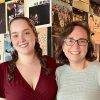Seven years of research on the Deepwater Horizon oil spill by scientists including Eckerd College professors and students has been turned into a multimedia resource called Beneath the Horizon.
The interactive website, which launched on April 20, was sponsored by Center for the Integrated Modeling and Analysis of the Gulf Ecosystem (C-IMAGE) and the Gulf of Mexico Research Initiative. April 20 marked the seventh anniversary of the Deepwater Horizon rig explosion that killed 11 workers and set off a chain of events that led to 210 million gallons of oil spilling into the Gulf of Mexico over 87 days.
A timeline of the spill, an interactive map of other spill locations in the gulf, videos about the recovery and human cost were all made possible by data collected through extensive research. Eckerd professors David Hastings, Professor of Marine Science and Chemistry, and Gregg Brooks, Professor of Marine Science, were able to use sediment cores to determine that changes seen and recovery rates of smaller seafloor creatures and help scientists come to the conclusion that areas of the Northern Gulf took two years to return to pre-spill conditions.
Eckerd students also contributed by participating in annual “Mud & Blood” science expedition cruises to collect sediment from cores a mile deep in affected areas. C-IMAGE announced that these expeditions will end in July.
The C-IMAGE Consortium was founded by the University of South Florida College of Marine Science and has grown to include research from Eckerd College, Florida State University, Georgia Tech University, Penn State University, Hamburg University of Technology, Texas A&M University, Texas A&M University Corpus Christi, University of Florida, University of Miami Rosenstiel School of Marine and Atmospheric Science, Universidad Nacional Autónoma de México, University of Calgary, University of West Florida, University of Western Australia, William and Mary College’s Virginia Institute of Marine Science, Florida Institute of Oceanography, Mind Open Media, Woods Hole Oceanographic Institute, Wageningen University and Research, Scripps Institution of Oceanography, and Mote Marine Laboratory.












